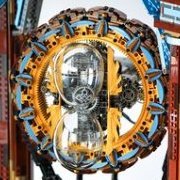Search the Community
Showing results for tags 'clock'.
Found 18 results
-

My mechanical clocks
Davidz90 posted a topic in LEGO Technic, Mindstorms, Model Team and Scale Modeling
A compact, gravity powered clock. There are many Lego clocks around, but most of them are really huge contraptions, and for a good reason. They are easier to tune, more eficient, work longer... So naturally I took a challenge to make something small but still usefull :P. The key component is the pendulum. Typically, a significant length is needed to get period of one second. Here, a second mass over the pivot point slows the tiny pendulum down, so that it can be many times shorter than usual. The compact "knife edge" pendulum suspension dramatically reduces friction, decreasing the power necessary to run the piece. The low mass of components creates many problems. The clock is reasonably accurate (I got it within 5 seconds per hour), but tuning was a nightmare, and even a sneeze can alter its rate. The power source is 100g weight on a string. Due to only one hour working time, I have decided to use only minute hand. Seconds hand puts too much power demand on the mechanism. 1 by David_Z1, on Flickr 3 by David_Z1, on Flickr Schem2 by David_Z1, on Flickr Many thanks for KEvronista for inspiration to get into this Lego clockmaking hobby :) [EDIT]: embedded the video. -

The Grand Astronomical Clock
Davidz90 posted a topic in LEGO Technic, Mindstorms, Model Team and Scale Modeling
I'm proud to present my newest build, which took me almost half a year: Grandfather clock with 19 different functions, possibly the most complicated Lego clock in the world. 20240210_133209 by David_Z1, on Flickr Standing almost 2 meters tall, this pendulum clock was an engineering challenge on multiple aspects, but the biggest problem was how to power all 19 functions and how to handle a highly variable friction produced by them. The answer was to use several electric motors triggered at the right time. There's no electronics, just mechanical contacts. Escapement - the central part of the clock that powers the pendulum, is powered by a small dropping weight that is frequently lifted back up by electric motor. This ensures a very steady input power, and thus good accuracy; the mean error is less than 3 minutes/day (after a day of working, it is off by less than 3 minutes). This is possible due to the use of John Harrison's grasshopper escapement, which is the most accurate type of pendulum clock mechanism. The electrical system is based on custom DC motors fitted with RCA plugs: 20240210_163033 by David_Z1, on Flickr Above You can also see the Westminster chime mechanism - at every quarter, it plays a melody like Big Ben. The chimes are made from aluminium pipes, 70-110 cm long, length tuned to specific musical notes. Here's the list of functions: Schem_front by David_Z1, on Flickr Schem_back by David_Z1, on Flickr And here a video demonstrating all of them: -

"Double helix" - a simple, efficient grandfather clock
Davidz90 posted a topic in LEGO Technic, Mindstorms, Model Team and Scale Modeling
I present my new build: over1 by David_Z1, on Flickr It is a 170 cm high grandfather clock, built with about 9000 bricks. The structure is meant to be bio-inspired, with a double helix (dna-like) pattern. The main load bearing element are four technic brick reinforced pillars at the edges, which are connected by the said helix-like grider structure. The power is provided by a pretty light (by my standards anyway :P) 0.3 kg weight. It is sufficient for 16 hours of operation. mainw by David_Z1, on Flickr The clock face is constructed mostly with 1x2 plates, the whole structure is under slight tension. over2 by David_Z1, on Flickr The hands assembly uses my new solution with worm gear. The minute hand (axle) is geared up 2:1 and then geared down 1:24 to differential casing, which holds hours hand. hands by David_Z1, on Flickr The escapement used here is a so-called Grasshopper escapement, invented by John Harrison. My particular implementation uses two wheels to make the whole mechanism completely symmetric. The system is highly efficient (needs 70 microwatts to run) and accurate (clock error is under 1 minute per day) escapement by David_Z1, on Flickr Video: -
1920s Art Deco modular "Ironwood Union Depot" - train station real world MOC
Murdoch17 posted a topic in LEGO Train Tech
This modular station was inspired by a long since expired Cuusso / Ideas project, (not mine), and set 2150 Train Station from 1996 while the clock tower is inspired by Big Bentley Bust-Out (from Cars 2 set 8639) from 2011. I added a removable six track long platform and put a luggage ramp from the street side for use by the wheelchair pieces LEGO recently made. By the way: the logo right below the clock is the official LEGO trains logo built in bricks, while the words in the center (just between the middle pillars) reads "Ironwood Union Depot" in printed 1 x 1 tiles. The street side of the station has been extended towards the edge of the base-plate, allowing for a more room (and more details!) inside the building. The year of the stations completion, 1928, is right above the main entryway. The lower floor has the central ticket desk, plus pizza restaurant (complete with opening oven!) on the right side with seating available on the left wing. These wings also allow for access to the platform under the twin canopies. The second floor has the switching control room and station managers office which floats inside the exterior walls on some tile-topped pillars. This assembly is barely connected to the build by two studs. (NOTE: No stairs to the upper floor were made because that's how the official CITY sets are, so I didn't include any as I was going for an official LEGO set feel.) This a closeup of the four-sided clock tower and brick-built LEGO Trains logo. The modular station features two platform sections, two lower roof sections, one upper roof section, and the removable second floor on top of a cafe (with seating) on the lower level. The station platforms fit via Technic pins while the other sections attach via a few studs. The station building shown above has been built since 2018. I've been trying to add a good looking canopy and passenger stairs to it since about late 2019, but gave up and added one that is solid in roof panels to my Disney-lookalike instead in early-to-mid 2021. Then, in early October I saw 76183 (Riddler face off from the new "The Batman" line) and knew I had found a solution to the pedestrian staircase between both platforms. I hashed out a better, more see-through version of the canopy on the MOD Disney station which should work... it has a half stud gap right now, but it most likely is an LDD problem instead of a design one. (I hope!) The stairs are a color changed MOD of the ones in the set with more space between the tracks and a bit more height in the middle section by way of bumping the whole structure up a brick or two. There is eleven bricks of clearance from the railhead to the bottom part of the arches, meaning the twin staircase's fit most of my trains through with room to spare. However, the pantograph's on electric loco's and a caboose cupola for a freight train won't fit under the bridges. This view also showcases the neat little hanging lights used under the canopy area itself. The bridges are missing eight black candlestick parts for the lights on the part of the walkway, where the stairs have their landings. I'll also have to cut the two 48 x 48's down by eight studs on one side per baseplate to better fit the footprint of the canopy. EDIT 11/9/21: This canopy project would would cost around three hundred US dollars (or more) if I didn't have 850 of the more expensive parts already found from my own collection and with serious help from my brother. Sadly, the Disney Station MOD's canopy has been sacrificed to make this project work as well. (Using those parts knocked it down to about $160 for what you see above.) Thoughts on new development or the original station? Comments, questions and complaints are always welcome! -
Finally it's done! For the past 10 months, whenever I've found the time, I've been working on my new project "Post Office". My first corner house from the Modular Building series. Besides the challenge of 45° angles in Lego to build nice and stable, the biggest challenge with the corner house was certainly the small space. You can also see the whole project under MOC-88507 - Post Office on Rebrickable. There you can also buy the building instructions as PDF. Best you make yourselves a picture of it, enjoy! As already mentioned, the Post Office is a modular corner building. The MOC consists of an old post office on the first floor, a design agency on the 1st floor and a small yoga studio on the top floor. The MOC has a lot of details on each floor. It is built on a standard 32 x 32 baseplate and includes 11 minifigures and a small mobile flower wagon. Ground Floor - Post Office On the first floor is an old classic post office with two counters. In the post office there are many details like a copier, a packing corner or postcard racks. Outside there is an ATM and a flower seller with a small flower wagon. 1st floor - Ninja Design - Design Agency On the 1st floor, next to the passage to the outside spiral staircase to the top floor, there is a small, fully equipped design agency with work desks, eating area and sitting area. Many details such as posters of print campaigns, awards, a bookshelf and a water dispenser enliven the modern furnished office space. 2nd floor - Yoga Studio Small yoga studio on the top floor with a locker room, a gong and a water dispenser. There is an old clock on the outside that can be operated from the roof. Roof From the 2nd floor, a ladder leads to the flat roof. The roof is deliberately kept simple next to two air conditioners has made a small bird comfortable on the roof.
- 10 replies
-
- modular building
- moc
- (and 12 more)
-
THE CLOCK TOWER Hi guys, finally here we have this MOC that I have been working on during months. This Diorama represents from the left to de right; The Whomping Willow, the Stone Circle entrance that connects to the Wooden Bridge that I have omitted for space reasons in this MOC, and Hagrid’s Hut. In the Back we have the section of Hogwarts that represents the Gryffindor Tower, the Clock Tower and also the North Tower, where the Divination classroom is located. After the completion of my last MOC, I decided that from then on each MOC that made the Hogwarts Castle would be based only on one or two films in order to recreate them as completely as possible. Because the clock tower is a new section in the Azkaban prisoner film, I decided to focus on this film, but when LEGO released the new Harry Potter sets I finally dedicated the castle to the first three Harry Potter films, thus recreating the final scenes of the philosopher's stone and the secret chamber. Hope you enjoy it! HOGWARTS CASTLE LEGO Moc by Etel Enzos, en Flickr HOGWARTS CASTLE LEGO Moc Interior by Etel Enzos, en Flickr LEGO Clock Tower Interior by Etel Enzos, en Flickr LEGO Hogwarts Clock Tower by Etel Enzos, en Flickr Harry and Dumbeldlore at Headmaster's Office by Etel Enzos, en Flickr Gryffindor Common Room by Etel Enzos, en Flickr North Tower by Etel Enzos, en Flickr Hagrid's Hut by Etel Enzos, en Flickr Rotating Hagrid's Hut Interior by Etel Enzos, en Flickr The Magical Chess challenge and in the back, the Flying Keys challenge by Etel Enzos, en Flickr Mirror of Erised room by Etel Enzos, en Flickr North Tower Section by Etel Enzos, en Flickr The Chamber of Secrets by Etel Enzos, en Flickr Potions Classroom by Etel Enzos, en Flickr Gryffindor Common Room by Etel Enzos, en Flickr Mad Eye Moody at Defense Against Dark Arts Classroom by Etel Enzos, en Flickr The Dungeons and Slytherin Common Room located in the back of the Main Stairs of the Entrace Hall by Etel Enzos, en Flickr Slytherin Common Room by Etel Enzos, en Flickr Dumbeldlore's Office by Etel Enzos, en Flickr Happy Halloween! by Etel Enzos, en Flickr
-
Hello everyone ! So I spent 1 month building an entirely functionnal Kit-Cat Clock with Studio. It's not totally finished yet because I would l'll need to buy the parts on Bricklink for making it IRL, but it's theorically viable. I already submitted the project on Ideas and will update the design as soon as I buy the pieces. Do you guys have any tips on the mechanism for making it more reliable ? If you are interested you can support my project here ;)
-
Do you remember Heroes III? City called Tower? Do you remember these small guys which were living in a big clock? :) They there are :) Gremlin's workshop by Ryszard Bosiak, on Flickr Gremlin's workshop by Ryszard Bosiak, on Flickr Gremlin's workshop by Ryszard Bosiak, on Flickr Gremlin's workshop by Ryszard Bosiak, on Flickr Gremlin's workshop by Ryszard Bosiak, on Flickr Gremlin's workshop by Ryszard Bosiak, on Flickr Gremlin's workshop by Ryszard Bosiak, on Flickr Gremlin's workshop by Ryszard Bosiak, on Flickr
-

Happy Hourglass
RoxYourBlox posted a topic in LEGO Technic, Mindstorms, Model Team and Scale Modeling
My latest MOC, “Happy Hourglass,” was built for Eurobricks’ collaboration, “Potion Shoppe,” displayed at Brickworld Chicago 2019. This project was originally planned as a time realm for Eurobricks’ world tree the prior year, but since I couldn’t make the trip, I repurposed the gears and clock face as a fanciful glockenspiel-style grandfather clock. As usual, the final design weighed in heavier than anyone anticipated, so the table underneath was designed and built last. For the tabletop, I sandwiched 2 layers of 4x (32x32) Technic brick grids originally planned as risers for my plot of land in Happy Mountain (EB BW17). The result was quite indestructible, as it didn’t sag a bit! For the table legs, I modified the poles from my River Wheel, filling the hollow center with perpendicular Technic bricks. The gears in both the turntable and clock face are another iteration of the high-torque gears from the River Wheel, this time adding 4 planetary gears inside the 11x11 Technic arches. Unfortunately, the 11x11 quarter circles don’t rotate smoothly when driven with 4 gears, since the driving gears all pass over the gaps simultaneously, leading to an eccentric, jerky motion. This led to frequent questions whether the hourglass had stopped working happily, only to be proven otherwise when it’d restart untouched within moments. As they say, there’s no stopping time! Happy Hourglass and the Potion Shoppe (topic and pictures soon forthcoming) won Best Mechanical and Best Group Display, respectively, at Brickworld Chicago 2019. View larger photos and videos on my flickr! Edit: I have posted an updated video here.- 18 replies
-
- 1/4 circle gear rack 11x11
- 24121
-
(and 2 more)
Tagged with:
-
(640x480).thumb.jpg.97b97cf52b621694f8ece5448230e728.jpg)
Motorized Harry Potter Clock Tower with Pendulum 75948 (Instruction)
Gideon8 posted a topic in LEGO Licensed
I have always wanted the original 4757 Hogwarts Castle because it had a clock and a pendulum! I found its clock works to be a GREAT mystery until I could look into its instruction manual! Lego was so gracious to create the new Clock Tower and release it! I loved it very much. However, a great feature was missing: the pendulum! I decided to make minimal modifications for adding a pendulum and even motorizing it! My Clock Tower's clock work would not be a GREAT mystery because I made a video which showed how I built it! -
Hi, My name is Lenka and I'm from Czech Republic. I'm going to ask you to consider supporting my Lego Ideas project - Astronomical Clock. We actually have astronomical clock in my hometown of Olomouc, but my LEGO astronomical clock is inspired by the one in Prague. What makes it cool? It's a minifig-scale build that can fit together with modular buildings and has a pretty neat functional mechanism (check out the update video!). https://ideas.lego.com/projects/5b9a9dcd-0e40-42ca-a5c5-fb26b56188cb
-
.thumb.png.116032e930e483fb4ebbfdc62183bd34.png)
[TC13] Pentagon Clock - Wind-up Pendulum Clock
Didumos69 posted a topic in LEGO Technic, Mindstorms, Model Team and Scale Modeling
Pentagon Clock This is a wind-up pendulum clock powered by two pullback motors. This clock is not true to real time but rather focuses on features such as a wind-up mechanism, pin wheel escapement and three concentric hands. It has been built completely in-system and can be reproduced without any fine-tuning, except for making all gears run smoothly of course (LXF-file here). The clock has a very consistent autonomy of 18 minutes. It features: A wind-up mechanism - A differential is used to prevent the hands from running counterclockwise when winding-up the clock. One of it's outputs is locked by default and slips during wind-up. Pin wheel escapement - Instead of using teeth, the escape wheel has three round pins that are stopped and released by a scissors-like anchor, which has been integrated in the pendulum. Three concentric hands - Planetary gears and a differential house make for a fictitious LEGO time system with 2 hours in a clock revolution, 5 minutes in an hour and 30 seconds in a minute. The pentagon-shaped clock face refers to the 5 minute hour. All features have been originally developed for this contest. -

A practical LEGO technic clock
dsharlet posted a topic in LEGO Technic, Mindstorms, Model Team and Scale Modeling
I've built a few clocks with LEGO over a few years, but none of them have been practical to use. To be practical, it needs to run for at least 24 hours, and be really easy to rewind. Having to spend more than 10-20 seconds with a winding wheel is too much of a pain (and my last clock took way longer than that!). The main difference between this clock and my other clocks is the drive weight is on a chain, and the chain can be simply pulled back through the clock to rewind it (driving a ratchet instead of the drivetrain), solving the ease of rewinding problem. Some other details: The escapement is a Galileo escapement with a 40 tooth wheel The hands can be moved forward by hand to set the time via a differential ratchet The drive weight is ~600g (11 boat weights x 53g, plus the parts to hold it together), the chain is a loop connected to the bottom of the weight to balance the drive weight The ratio between the chain and the escapement is 416:1 (40:24, 2:1 differential, 40:8 x 3) The weight falls 2.59cm/hour, so with 3 feet of drop, the clock will run for about 35 hours (it's currently mounted a little over 5 feet off the floor, so it could be given enough chain to run for about 60 hours). It should be accurate to within a minute per 24 hours, but it will take some time to dial in the position of the bob on the pendulum The single thing that helps the most with efficiency is a knife edge suspension for the pendulum, I learned this technique (and probably other techniques too) from https://www.youtube.com/user/KEvronista and https://www.youtube.com/user/BenVanDeWaal Here's a video: And here's a slow motion video of the escapement: I hope you find it interesting! I wanted to share the chain drive technique because I haven't seen it before, and it really makes a LEGO clock a lot more fun and less of a pain in the butt than a string on a spool :)- 1 reply
-
- escapement
- galileo
-
(and 3 more)
Tagged with:
-
While the Department of Time generally ensures close watch of time for all citizens, some prefer having personal access to the hour of the day. Such access can be ensured by the use of a clock, but as a clock is a piece of fine machinery, it needs an expert hand to keep it running accurately. Recently, such an expert hand has arrived in King's Harbour and has set up a respectable establishment in the centre of the commercial district. On the ground floor, his wife handles the customers, both those who are looking to buy, and those who needs a mechanism serviced. And on the top floor, he services the clocks in peace and quiet in the well-lit room with his special tools and worktable. A small artisan for King's Harbour. It was fun building those clocks. C&C welcome:)
- 11 replies
-

[WIP] LEGO Clock
princeofgonville posted a topic in LEGO Technic, Mindstorms, Model Team and Scale Modeling
Hello Eurobrickfans. This is my first Forum post, so please forgive any netiquette errors. I am attempting to build a functional clock in LEGO. Progress is posted on my blog at www.wis.co.uk/lego (among other things I'm building). Here is a short Youtube of current progress: Thanks Justin -

[MOC] Fully automatic Clock
Gonkius posted a topic in LEGO Technic, Mindstorms, Model Team and Scale Modeling
This is a fully automatic clock that was finished end of 2014. So, why do I call it "fully automatic"? - The clockwork runs as a normal mechanical clock with a pendulum and counterweight. - There is a motor that winds the clock every hour. - The speed of the clock is adjusted once a day using the Mindstorms unit. The speed is adjusted by changing the length of the pendulum. In total, the clock runs for itself without any assistance, and it shows the right time, even if it is build using only LEGO bricks. (Apart from the string to the counterweight) There have been many challenges in this design. My main focus, except the obvious goal to make everything to work, was to make this as compact as possible. The whole clockwork fits inside 14x14x14 studs. I did a short video to show the "action": The two sensors are used for: 1. Stop when the counterweight is fully winded 2. Give feedback from the minute hand rotation back to the Mindstorms unit. The counterweight is made out of 12 train/boat weights and is about 0.68kg. Winding is done through a differential to avoid interruptions during the winding. There are two medium motors inside the clockwork for the winding and adjustment. The Mindstorms unit is hidden in the base behind a hatch: WIP pictures Specially designed differential gear to reduce the friction between the counterweight and clockwork as much as possible. The winding motor rotates the large turntable gear: Clockwork prototype, without any automation: Very first prototype of the escapement:- 11 replies
-
- automatic
- differential
-
(and 6 more)
Tagged with:
-
Gotham Anarchy The Dark Knight infiltrates Gotham Clock Tower to take down Anarky; a criminal mastermind and terrorist who is planning to blow up the landmark. Gotham Hostage Gotham Anarchy Enjoy! ~Nemo
-
A creation based off of the episode “The Clock King” from Batman the Animated Series. I rather like the Clock King, and while his appearance in JLU Animated is cooler, he nonetheless is great in B:TAS too. I went for the gear look on this build like in the episode, and added in more clocks for looks. Unfortunately I had to change the “death torture” of Mayor Hill so I could include all three characters in the same scene. Anyways I’m glad with how it turned out. Enjoy ~Nemo


